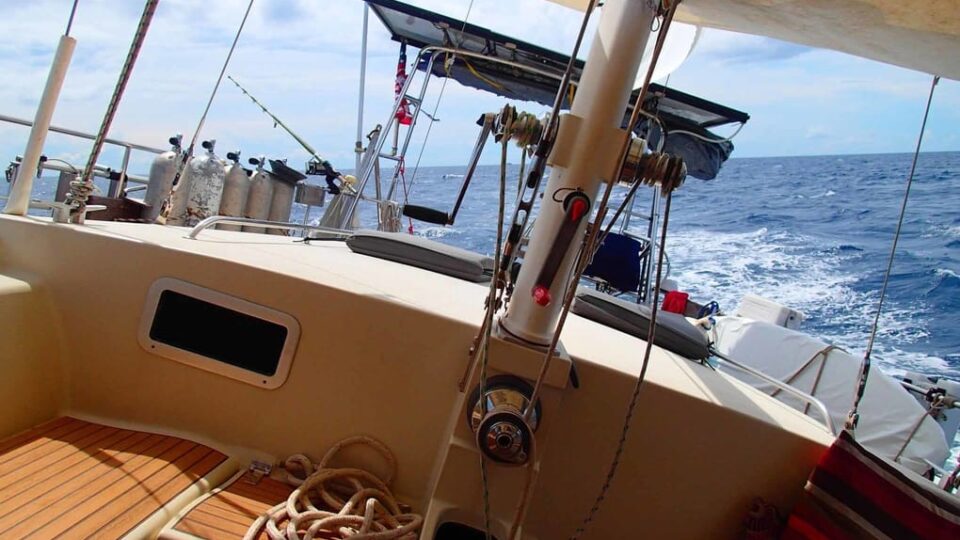Can Sailboats Tip Over?
Whether you are a beginner or an experienced sailor, it is normal to ask yourself if there’s any possibility for your sailboat to tip over. But what does it mean for a sailboat to tip over? It means that it’s turned upside down or on its side when it’s in the water. This is called capsizing or keeling over. When sailboats are under wind power they usually unbalance due to the wind’s force. Therefore, they seem to be very vulnerable to tipping. So, it’s totally normal to wonder if a sailboat can capsize and this is one of the sailors’ main fears. I don’t want to frighten you but the truth is that it’s possible that your sailboat tips over. However, in this article I’m going to explain to you how this can happen, why and what can you do in order to prevent it. So, follow me!
Why Does a Sailboat Capsize?
Firstly, when we say that a sailboat is capsizing or keeling over, it means that it’s tipping over. So, we basically have three terms for capsizing. So, how can we prevent this from happening? In order to correct this, you have to follow a procedure called righting. Righting is the act of reversing a capsized vessel in the water. There are some sailboats that are self-righting, meaning that they can prevent themselves from tipping over. Basically, self-righting involves using the low center of gravity of the sailboat and the buoyancy of a watertight cabin on the boat. When these two things are not applied then it’s much easier for a sailboat to capsize. Most sailboats and yachts have inset these features so it’s unlikely for them to tip over.
Reasons Why a Sailboat Could Tip or Keel Over
- Speed: The faster your sailboat is going the higher the risk. In case you hit a rogue wave at top speed, then it is likely for the sailboat to keel over. Furthermore, if you try to turn too quickly at speed it’s possible to tip over your sailboat the same way you would roll your car.
- Operational Mistakes: It’s normal for beginner sailors to make mistakes. However, these mistakes might lead to loss of the sailboat’s stability or misuse of the anchor! Moreover, in case the sailboat goes off balance and thus losing its stability, this would be a probable cause for capsizing.
- Weather: Bad weather, like a storm, can also cause capsizing to your sailboat. If the winds are strong you might also lose your sail. Remember that the mast and sail of your sailboat are essential for keeping your boat upright. That’s why it’s vital to dropping your sail in strong winds. Furthermore, when strong winds hit the side of your sailboat when it’s climbing a wave, then it can cause it to roll. So, always prepare yourself to prevent any of the above-mentioned issues.
- Distribution of weight: What else can cause instability to a sailboat? The uneven distribution of weight. Above all, always make sure to equally distribute weight on the sailboat.
- Center of gravity: Any modification to the sailboat can increase the center of gravity. And like this, the sailboat will be unstable. In addition, this applies when there’s a cargo that is not well placed in your sailboat. This can lead to progressive rolling and increases the chances of your sailboat tipping over.
Keel and Heeling Over
Physic’s law says that the weight of the keel works in balance with the forces of the wind in the sails. This means that the weight of the keel is engineered to overcome gravity and wind. When your sailboat is under sail, the wind fills the sails and the boat leans over. This is called heeling. So, sails have to be correctly selected and trimmed to the proper conditions, in order to prevent heeling over. When you have too much sail out this causes wind pressure, and therefore overpowers the sailboat.
Also, when the keel or ballast leans towards the surface, gravity pulls the keel and mast back into their natural vertical position. Remember that sailboats are scientifically designed to heel and that makes it almost impossible for them to capsize. This is due to the fact that when a sailboat heels, it exposes a lower surface area to the wind, thus reducing the pressure on the wind.

Prevent your Sailboat from Capsizing
Firstly, in order to prevent your sailboat from capsizing, you need to avoid instability. As explained before, instability can be caused by too much weight in the boat. So, make sure to keep your boat lightweight and that weight is distributed evenly. Keep in mind to keep three points of contact with the sailboat, while moving around. Moreover, when you’re taking turns, try to take them wide and at a safe speed. Like this, you’re reducing the risk of losing balance. Last but not least, don’t forget to take waves head-on with the bow.
And What if My Sailboat Tips Over?
- Assess the damage. Is your sailboat going to sink or is it going to right itself?
- In any case, put on a lifejacket. Make sure that everyone on the sailboat wears a lifejacket.
- Try to roll the sailboat back over, if possible.
- If it’s not possible to roll the boat back over, then it’s preferable to stay with it.
- Try reaching the top of the sailboat and out of the water. This way you’ll preserve your energy and slow down hypothermia.
- If you can’t apply anything from the above-mentioned, then try signaling for help.
>>Also Read: How To Right a Sailboat
What Types of Sailboats Capsize Regularly?
The most vulnerable sailboats to capsizing, are the ones that have a centerboard and not a heavy keel. This is because there is no heavy counter-weight below the surface, like in a water ballast style sailboat. Subsequently, there’s no engineered righting solution in case of an overpowering gust. This kind of sailboats is quite small with approximately 2 or 3 seats. The most stable sailboats are the catamarans or trimarans. These boats don’t have a weighted keel that serves like monohull sailboats. Cats are two hulled boats and this offers many advantages in comparison with traditional sailboats. Moreover, their design makes them suitable for shallow water sailing. Cats are also wide and long, which makes them particularly stable in almost any condition.
Can Sailboats Tip Over? – Summary
Yes, sailboats can tip over but as described above, it is difficult to do so. However, sailboats for cruising are designed to be sailed responsibly therefore they won’t capsize if they follow the above-mentioned principles. The sailor is also responsible for ensuring that his sailboat is appropriately set up for varying weather conditions. We sailors, have to be responsible and observant in order to prevent any unexpected issues like a storm, really strong winds, etc. If that’s the case, then the best thing to do is to head back to the marina. In general, sailboats that are water ballasted or have a keel, can not tip over or capsize, under normal sailing conditions. They can not flip upside down and they’re actually self-righting in case of a blowdown. Anyway, in case you find yourself with a capsized boat, remain calm, and follow the outlined steps.
